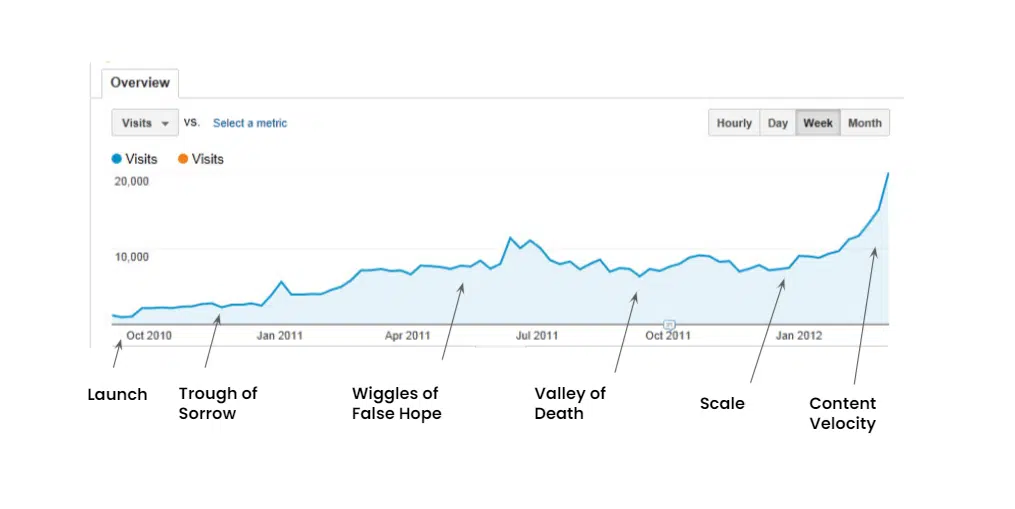Content Marketing is hard; don’t let anyone tell you that it is easy. I’m not pessimistic, but it is a known reality that content marketing needs time to show results. It takes years of hard work and consistency to build that content marketing growth curve.
After years of effort, my personal marketing blog finally reached 100,000 monthly visits this year. I’m not here to boast about how I accomplished this, as it took me nine years. I probably have a lengthy list of things you should avoid doing to accomplish this task in less time.
I achieved this figure entirely on my own; granted, I occasionally collaborated with freelancers to develop content or assist with SEO, but it has been a solitary struggle to reach this level. Almost all the groundwork that was required to do this was established in the previous five years.
Bursting the Marketing Knowledge Bubble
The idea of starting the blog occurred somewhere at the beginning of 2012. I couldn’t get enough resources on marketing that addressed the issue from an Indian perspective. Thus, the concept was straightforward: read as much as possible, experiment at work, or undertake a side project and document the experience on the blog.
But here is what I didn’t know. I had no idea what SEO was. Nada. A Big Zero. I had roughly three years of experience, and while I had a theoretical grasp of SEO, the agency handled most of the actual work.
They would visit the office once a month to deliver a report outlining our SERP ranking, our performance on organic search results, and the actionables planned for the following month.
However, they would not reveal their approach, how they accomplished their goals, or how they would optimize and enhance performance when something did not work. As a client, you wouldn’t care much as long as they got the results you wanted.
Additionally, agencies are averse to disclosing their trade secrets. If they disclose what they did explicitly, you will replace them with an internal resource or another agency.
There is a veil of secrecy in the SEO business. I can’t think of a single agency that will explain what exactly happens in the backend. Thus, if you have no prior experience with actual search engine optimization, you may believe it is simple, but it is not.
Then came the hard part, which was writing. I couldn’t write well even if I tried really hard. Most of what I wrote in the initial years ended up in the trash. Writing takes years to perfect, especially SEO-focused writing is even harder. It took many self-help books, reading, rewriting to reach the level you see on this blog.
I still think most of my writing is mediocre. But I have learned to expect that you can never be satisfied with your own writing; you have to keep working towards it.
Then came the final nail in the coffin – development. I knew nothing about website frontend and backend. The site was hosted on Blogspot for the initial few years, so I never had to think about this. However, it wasn’t until I switched to WordPress that I understood what I was missing.
Today, I obsess over every aspect, including the theme, plugins utilized, image compression, and scripts enabled. While this is not a healthy obsession, you understand how a website is managed. Yes, the scale is miniature compared to some big companies, but you understand what happens behind the hood.
It took years for me to improve at some of these aspects, and during the course of the site’s existence, it has contributed to bust my knowledge bubble.
You might be the CMO of a major brand, for all I know. Still, I am certain you would be unaware of some of these issues if I began delving into the specifics. Most executives are typically glorified, personnel managers and lever operators.
While they may be highly competent at doing the work at hand, they will never understand what goes on behind the scenes since they rely on others to complete the task.
Content Marketing Growth Curve Explained
Every content website goes through certain stages before it reaches critical mass. The content marketing growth curve that I’ve developed is partially adopted from the startup curve that Paul Graham and Trevor Blackwell developed. I’ve used some of the terms that Paul and Trevor coined for their original startup curve.
I believe every content website/blog goes through some of these stages, and I had my own experience of witnessing this first hand. However, your experience is relative to the industry and niche you choose.

In my own experience, it took me nine years (I had practically hit the snooze button in the first four years, so I really wouldn’t count them). So it would be appropriate to say that it took me five years to cross the 100K month visitors mark.
There are six stages that every website, publication, or blog goes through. Let me spend some time explaining each stage, and the entire cycle can take a minimum of 2-3 years.
1. Launch
This is the stage at which the site is launched, and you begin tossing stuff at the wall to see what sticks. The initial few pieces of content will set the stage for what comes next.
This is also the phase where you are most excited about the site’s prospects because you can easily switch gears if your content marketing strategy isn’t working. Most of the initial traffic will come from direct or referral traffic, so you will have huge traffic spikes when the content goes live, and then it plateaus after it is published.

Naturally, you have a high bounce rate because nobody knows your site, and if you are someone who doesn’t have much influence, then chances are the initial set of users won’t even come back.
Of course, there are expectations to this rule, but that essentially means you have a product or service integrated on the site which users found useful.
2. Trough of Sorrow
This is the stage at which self-doubt sets in, and you begin to feel as though you should abandon the project entirely; if you are doing this along with a full-time job, you will find it difficult to manage the project.
Personally, this is the stage where I realized how little I knew about SEO and content writing. You also realize that what you thought was exceptional content by your standards was garbage by Google’s standards. The number one mistake that most content creators make is writing what they like and not what works for search engines.
Yes, you can continue to pursue this strategy if you are Seth Godin, Bill Gates, or Nassim Nicholas Taleb. It is important to cherry-pick topics that are relevant from an SEO perspective in the initial stages.
Most content creators get their search analysis wrong in the initial stages, and that stifles their growth.
3. Wiggles of Hopes
Your site’s traffic stabilizes at this point, and you no longer observe a flat line. People have begun to notice your site due to previously released content, and you also have a modest but increasing number of returning visitors.

You also notice instability in this stage as Google keeps correcting your SERP ranking, and your traffic keeps fluctuating. But you will notice a small but significant number of organic backlinks getting created as a result.
It is important to keep refining your content based on the feedback loop created during this stage. You will also have to separate the noise from the data by not getting obsessed with vanity metrics.
4. Valley of Death
If you were to give up the project, this is most likely where it will happen. You pretty much feel like Harry Potter, who is being pursued by dementors. In this stage, you will witness a significant dip in traffic which could result from algorithm changes, competition outranking you for certain topics, or technical issues on your website.

If you don’t address the issues and make long-term corrections promptly in this stage, it will most likely stall your growth. I’ve personally seen many sites losing their traffic, domain authority, and backlinks when they go through this stage.
If you have used any shortcuts to reach this stage, you would certainly face repercussions in this stage. It’s easy to succumb to temptations early on when someone promises to boost your traffic, links, and rankings in exchange for money.
However, SEO has karma, and it will almost certainly come back to haunt you at this stage.
5. Scale
You truly start scaling your content marketing efforts at this stage. If you were preparing for a marathon, everything up to this point seems like practice. There are a couple of things that make scaling possible.

With 50-100 pieces of content, your domain authority has risen to a respectable level, making indexing new content simpler. You’ve also improved your search analysis skills. People who are now visiting your site have most likely visited the site before.
As a content creator, you are no longer tossing things at a wall. You most likely know which piece of content will work and which will not.
6. Content Velocity
If there ever was a nirvana stage in content marketing, this would be it. Needless to say, very few blogs, websites, or publications ever reach this stage. If you are a writer, you would have most likely published few best-sellers, or you are a chef working towards his third Michelin star.

While there is heightened pressure to deliver exceptional content, everything you do in this stage sticks; you have managed to do what very few brands do. You have managed to build a center of gravity around your content.
There seems to be an escape velocity once you reach 1M views per month. This is probably the only stage where you can really say that content marketing has become ‘easy.’
Final Thoughts
It takes to shape the Content Marketing Growth Curve, and the timeline is relative to your industry and the content experience that you build. But every content site goes through the same trajectory; while some emerge stronger, others fail.
Keep iterating unless you find your audience and go on to build that center of gravity around your content; once you do, stay for the long haul and work patiently towards the end goal.
